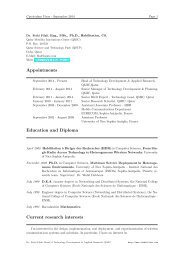Performance Analysis of the Actuator Discovery Protocol ... - Fethi Filali
Performance Analysis of the Actuator Discovery Protocol ... - Fethi Filali
Performance Analysis of the Actuator Discovery Protocol ... - Fethi Filali
Create successful ePaper yourself
Turn your PDF publications into a flip-book with our unique Google optimized e-Paper software.
<strong>Performance</strong> <strong>Analysis</strong> <strong>of</strong> <strong>the</strong> <strong>Actuator</strong> <strong>Discovery</strong> <strong>Protocol</strong><br />
for Mobile Sensor and <strong>Actuator</strong> Networks<br />
Muhammad Farukh Munir and <strong>Fethi</strong> <strong>Filali</strong><br />
Abstract<br />
This paper presents <strong>the</strong> performance analysis <strong>of</strong> our proposed energydelay<br />
aware coordination protocol, ADP [1] (<strong>Actuator</strong> <strong>Discovery</strong> <strong>Protocol</strong>)<br />
for mobile SANETs (Sensor and <strong>Actuator</strong> Networks). We have presented<br />
our analysis on ADP for static SANETs in an earlier work and it is shown<br />
that ADP provides optimal attachment for a sensor node to <strong>the</strong> actuator with<br />
minimum cost. For <strong>the</strong> sensor-actuator coordination, <strong>the</strong> proposed ADP can<br />
guarantee ordering, synchronization and eliminates <strong>the</strong> redundancy <strong>of</strong> actions<br />
[1]. In this work, we present our analysis on <strong>the</strong> dynamics <strong>of</strong> ADP<br />
to handle mobile sensor and actuator applications. The interval chosen to<br />
validate <strong>the</strong> acquired paths through ADP due to mobility can be a direct<br />
mapping <strong>of</strong> application’s energy and delay constraints. Our NS-simulations<br />
show that <strong>the</strong> total-energy consumed to validate <strong>the</strong> paths for time-stringent<br />
traffic is actually less compared to <strong>the</strong> overall energy consumed during arbitrary<br />
transmission <strong>of</strong> sensor data to-wards <strong>the</strong> sink. We have utilized a<br />
random way-point mobility model in our ns-simulations and analyze <strong>the</strong> performance<br />
<strong>of</strong> ADP in terms <strong>of</strong> energy estimates for maintaining paths (toward<br />
<strong>the</strong> optimal-actuator) in order to keep a promised QoS for time-stringent applications.<br />
The proposed ADP has also achieved a good balance for sensor<br />
energy-consumption while keeping a low end-to-end delay (optimal number<br />
<strong>of</strong> ’message-exchange’ to keep <strong>the</strong> paths updated).<br />
Keywords: SANETs (Sensor and <strong>Actuator</strong> Networks), self-organization,<br />
coordination protocols, energy and delay aware coordination protocols.<br />
ii





